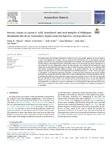Mostrar o rexistro simple do ítem
Genetic characterization of wild, broodstock and seed samples of "Polititapes rhomboides" (Bivalvia: Veneridae): implications for hatchery seed production
| dc.contributor.author | Chacón, Ginna M. | |
| dc.contributor.author | Arias-Pérez, Alberto | |
| dc.contributor.author | Freire, Ruth | |
| dc.contributor.author | Martínez, Luisa | |
| dc.contributor.author | Ojea, Justa | |
| dc.contributor.author | Insua, Ana | |
| dc.date.accessioned | 2021-04-21T15:02:42Z | |
| dc.date.available | 2021-04-21T15:02:42Z | |
| dc.date.issued | 2021-03-13 | |
| dc.identifier.citation | Chacón, G.M., Arias-Pérez, A., Freire, R., Martínez, L., Ojea, J., Insua, A., 2021. Genetic characterization of wild, broodstock and seed samples of Polititapes rhomboides (Bivalvia: Veneridae): Implications for hatchery seed production. Aquac. Reports 20. https://doi.org/10.1016/j.aqrep.2021.100658 | es_ES |
| dc.identifier.issn | 2352-5134 | |
| dc.identifier.uri | http://hdl.handle.net/2183/27785 | |
| dc.description.abstract | [Abstract] The banded carpet shell Polititapes rhomboides is a fishery resource and a suitable candidate for the development of native clam aquaculture in Europe. Here, we analyzed nine microsatellite loci in wild samples to provide estimates of genetic diversity and population differentiation for NW Spain, the main production area of this clam. We also analyzed wild-caught broodstock and hatchery-reared seed to investigate the genetic consequences of seed production for stock enhancement purposes by mass spawning. We examined the seed sample as a whole (total seed), but also subdivided it into three size classes to assess the genetic consequences of size grading. While wild samples, broodstock included, displayed minimal or no genetic differences, the total seed showed a reduction in allelic richness (12–24 %) and a significant level of differentiation (FST = 0.026−0.043) with respect to wild samples. After performing parentage assignment, we detected a drastic reduction in the effective number of breeders (Ne) compared to the census number (85 %), and an inbreeding rate of 0.036 per generation. The low Ne and high inbreeding rate were mainly due to high variance in reproductive success. The seed size classes also showed a decrease in allelic richness and significant genetic differentiation, but we did not find significant differences in parental contribution to each size class. Our results may help the genetic-assisted management of wild populations, give insight into the genetic composition of the seed produced by mass spawning and provide a basis for the development of more effective hatchery practices and sustainable stock enhancement programs in P. rhomboides. | es_ES |
| dc.description.sponsorship | Xunta de Galicia; 09MMA030508PR | es_ES |
| dc.language.iso | eng | es_ES |
| dc.publisher | Elsevier | es_ES |
| dc.relation.uri | https://doi.org/10.1016/j.aqrep.2021.100658 | es_ES |
| dc.rights | Atribución-NoComercial-SinDerivadas 3.0 España | es_ES |
| dc.rights.uri | http://creativecommons.org/licenses/by-nc-nd/3.0/es/ | * |
| dc.subject | Polititapes rhomboides | es_ES |
| dc.subject | Genetic diversity | es_ES |
| dc.subject | Mass spawning | es_ES |
| dc.subject | Parentage | es_ES |
| dc.subject | Effective number of breeders | es_ES |
| dc.subject | Size grading | es_ES |
| dc.title | Genetic characterization of wild, broodstock and seed samples of "Polititapes rhomboides" (Bivalvia: Veneridae): implications for hatchery seed production | es_ES |
| dc.type | info:eu-repo/semantics/article | es_ES |
| dc.rights.access | info:eu-repo/semantics/openAccess | es_ES |
| UDC.journalTitle | Aquaculture Reports | es_ES |
| UDC.volume | 20 | es_ES |
| UDC.startPage | 100658 | es_ES |






